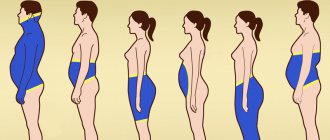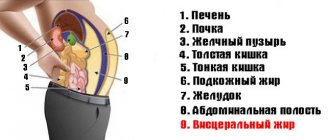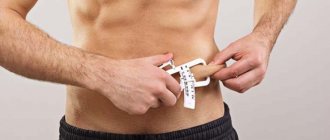Difference 1. In men, fat is deposited in the upper abdomen
And in women - on the sides, hips and lower abdomen. This is a consequence of the different hormonal levels of the sexes. At the same time, fat from the upper abdomen (“beer belly”) is somewhat easier to burn through exercise and diet. But you shouldn’t envy the male tribe. Nature has made it easier to burn this fat for a reason, but because it is extremely dangerous to life. The fat in the upper abdomen is located not only under the skin, but also between the internal organs (the so-called visceral fat). Therefore, it surrounds the heart, liver, pancreas and other important organs, and leads to their obesity. It has been proven that visceral fat increases the risk of heart attack, coronary atherosclerosis, fatty liver disease and a number of other diseases.
For women it's the other way around. Fat on the sides, hips and lower abdomen is intended by nature as a supply of nutrients during pregnancy and breastfeeding and as a safety cushion for the unborn child - it will protect him in the event of a mother’s fall or hypothermia. It’s our misfortune that, even after becoming a grandmother, we allow ourselves to eat so much that it’s enough to create a reserve, like for a future mother. Nature, in which animals often have to starve, has provided everything in such a way that it is very difficult to part with the female reserve. In the fat cells of these areas, for every 6 storage receptors there is only 1 expenditure receptor! That is, the body must have a really very good reason to receive energy from the female reserve. Therefore, a woman’s figure depends more on proper nutrition and regular physical activity than a man’s torso.
How is the presence of visceral fat determined?
The accumulation of fat in the abdominal area does not mean that it is visceral fat that has been deposited there. Abdominal fat can also be subcutaneous. The only way to accurately measure the amount of visceral fat in the body is with a CT or MRI scan.
However, doctors often rely on general recommendations to estimate the volume of this fat. For example, you can estimate the volume of visceral fat by measuring your waist circumference. Harvard Women's Health Watch writes that women's risk of problems from visceral fat increases if their waist circumference is 35 inches (89 cm) or greater. According to the Harvard T.H. Chan School of Public Health, health problems may occur in men whose waist circumference is 40 inches (102 cm) or greater.
What to eat to lose weight. Special menu for fasting day Read more
Difference 2. Men are entitled to more calories.
And it's easy to explain. They are taller, so even when they are thin they have more body mass. They have more muscle and a faster metabolism. Usually they do more physical work, even the most basic ones - rearranging a chair, carrying a child’s bicycle. All this allows men to claim 250–300 additional kilocalories per day. Therefore, the lower limit of daily caloric intake for women is considered to be 1200 kcal, and for men – 1500. If you eat less, both will begin to slow down their metabolism. The internal organs will starve, but fat will still be deposited. The recommended intake in the presence of training for women is 1700–2000 kcal, and for men – 2000–2300 kcal. The increase in calories should occur evenly through proteins, fats and carbohydrates, and not just one thing.
Complete exclusion of fat from a man's diet can lead to impotence!
How to remove belly fat for a man
Before you start fighting belly fat, you need to realize the need to take care of your own health, and only then strive to make your body beautiful. To achieve results, you should act consistently:
- Set a goal, define a deadline. Measure the volume of the abdomen, write down the parameters in a diary. Once a week, evaluate changes that will motivate you to move forward. If this is not done, losing weight can take years.
- Think about which bad habits you can give up and which ones you can change. For example, walk more, rather than travel in a car, stop using the elevator.
- You shouldn’t think about refusing food or fasting – such thoughts will lead to stress . The body will begin to require more nutrition, and a constant feeling of hunger will appear. Instead, review the menu and replace some foods with low-calorie ones.
- Find a hobby that will replace the pleasure of food. Someone has long dreamed of starting to ride a bike, reading a book, or learning a language. During the time spent doing what you love, there will be no time to think about food.
Nutrition rules
Belly fat in men can be eliminated by revising the menu. It is not necessary to go on a diet, following a diet invented by someone. It is important to understand which foods it is advisable not to consume, and which ones should become the basis of the diet:
- You cannot abstain from food for a long time, waiting for the feeling of hunger to appear. It is better to distribute meals so that there are no more than 3 hours between them. Small meals are the key to avoiding overeating during meals. Make sure that the portion on the plate does not exceed 1 cup (200 ml).
- Review food processing methods. Instead of frying meat and vegetables, it is better to bake, boil, or steam them.
- Instead of fatty pork, eat chicken (breasts), turkey, and veal. Eat proteins at lunch and in the afternoon, carbohydrates in the first half of the day.
- Exclude sauces and savory snacks from the menu, limit the consumption of bread and fast carbohydrates (sweets, baked goods), smoked and fried foods. A good way to improve your well-being and speed up energy metabolism (metabolism) is to give up alcohol.
- Chew food thoroughly, do not swallow large pieces.
- Water is a real belly fat burner for men if you use its properties correctly. Strictly observe the drinking regime - drink at least 2 liters of liquid per day. It is important to distribute water evenly throughout the day, but drink most of it in the first half of the day.
Difference 3. Men treat food differently
On the one hand, it is psychologically more difficult for a man to stick to diets, on the other hand, he would rather not eat his stress with sweets, like us women, but would rather drink alcohol. An interesting study in this area was recently conducted by psychologists from McMaster University (Canada). It turns out that to lose weight, a woman should have lunch and dinner with a man. And not necessarily a husband or friend - at least with a boss. The researchers observed 198 small groups of people eating in three university cafeterias, totaling 469 people. It turned out that a woman having lunch or dinner with a man always chose food with less calories than in the presence of a friend or in a female company. In mixed companies, women's choices were closer to the dietary ideal the more men there were at the table. But the presence and number of representatives of the fair half of humanity had no effect on the appetite of the stronger sex.
Why is abdominal obesity dangerous in women?
The appearance of excess weight, accompanied by the accumulation of fat deposits of the android type, is dangerous due to the development of hormonal imbalance. In women, the adrenal cortex and ovaries begin to produce male sex hormones. This leads to disruption of the menstrual cycle, problems with conception, and male pattern hair growth. Visceral obesity in women is dangerous due to the following consequences:
- dysfunction of the digestive system;
- increased blood pressure;
- dyspnea;
- fatty liver;
- hypertension;
- atherosclerosis;
- diabetes.

Articles on the topic
- Causes of obesity in women - congenital, nutritional, psychological
- Exogenous-constitutional obesity of the 2nd degree - therapy and diet
- Exogenous-constitutional obesity of the 1st degree in men, women and children - diet
Difference 4. Safe weight loss rate
Nutritionists around the world have agreed that there are some approximate figures: how many grams per week it is safe to lose weight. If you lose weight faster, there is a risk that the various systems of the body will not have time to rebuild. In addition, weight lost quickly is often gained back just as quickly. So, the safe rate of weight loss for women is 0.2–0.5 kg per week (that is, up to 2 kg per month). And for men – 0.2–1 kg per week (up to 4 kg per month, that is, twice as fast). The top figure in both cases is intended for those who have 20 kg or more of excess weight; the rest should lose weight more slowly.
There are four main causes of obesity.
Often, to justify themselves, overweight people say: “It’s hereditary, my parents were the same.” Doctors call this type of obesity exogenous-constitutional. 90% of all obesity cases are of this type. Heredity can influence the course of metabolism; different body weights among people of the same height and age are 40% determined genetically. But often the reason lies not in genetics, but in the family lifestyle and nutritional skills instilled in childhood, because the formation of adipose tissue begins from the thirtieth week of pregnancy and ends by a year after birth. The body of a newborn contains 5-6 billion fat cells, and by the age of 20 their number increases approximately 6 times and reaches 30-40 billion. A weight gain of 10-15 kg can cause an increase in the number of fat cells. This type of obesity develops at a very young age. It is best to begin treatment of hereditary obesity when body weight exceeds the ideal by no more than 50%.
Three other types of obesity are known. If a person eats a lot but moves little, nutritional obesity develops. Cerebral obesity develops if the functioning of areas of the brain responsible for regulating fat metabolism is impaired. Children with this type of obesity have slower sexual development. They complain of headache, dizziness and fatigue, shortness of breath. Their blood pressure rises. They constantly feel hungry and thirsty. When the formation of certain hormones is disrupted, endocrine obesity develops.
Some people convince themselves and others that they feel spacious in their curvy body. “The more good people, the better”, “while the fat one dries, the thin one will die”, etc. In Russian villages it has long been believed that a thin woman is sick and useless. Those who claim that they are quite satisfied with solid volumes should be warned. The accumulation of 4-5 kg of excess fat in the body already creates a shift in metabolism sufficient for the development of many unpleasant phenomena. A significant increase in body weight leads to disruption of a number of important rhythms in the body and the appearance of premature metabolic changes characteristic of the disease state.
Difference 5. Most men usually lose weight faster than women.
Sometimes this causes their wives to be in a bad mood. Imagine: you’ve been eating cabbage salad together for the third week, but your weight remains the same, and your spouse’s third kilogram is already flying off! Injustice? Yes, but it has a scientific basis. Men naturally have more muscle mass than women, and they also have higher levels of the male hormone testosterone, which helps build muscle mass. As a result, their metabolism is also faster. So, all other things being equal, the male body burns calories more successfully.
Please note - all other things being equal(!). This means that the man and woman being compared eat properly and have a normal level of physical activity. If a woman runs in the morning and works out with dumbbells, and her husband sits with beer and chips in front of the TV, then the lady, despite her gender, can easily have more muscle mass than her husband. On the contrary, there is less adipose tissue!
The main causes of fat deposition in the abdomen and sides

Most of the reasons for the appearance of belly and flank fat in women and men are similar:
- abuse of beer drinks, which cause hunger and increase estrogen levels, as well as increase gas formation and worsen digestion;
- poor emotional state, stress, anxiety and depression;
- non-compliance with the work and rest regime - improper relief from stress;
- incorrect, inappropriate diet, consumption of foods that are difficult for the body to digest, as well as abuse of fats and sweets;
- illiterate nutritional culture - long breaks between meals, too large portions, irregularity: skipping breakfast or hungry days;
- drinking alcohol and smoking;
- lack of the required level of physical activity;
- improper daily routine, constant disruptions of biological rhythms - the female body is especially sensitive to this;
- hormonal imbalances, lack of nutrients and other beneficial substances.
Women are especially susceptible to unhealthy diets. After them, the accumulation of fat only intensifies, and after a while the kilograms return. Age-related changes worsen the picture - after 30-35 years, metabolism slows down significantly, and every extra cake becomes a serious test for the figure. Estrogen production decreases and metabolism deteriorates.
Difference 6. Men need to eat more meat than women.
This popular belief was born from the fact that men require more protein. It is generally recommended that women get 15-18% of their calories from protein, while men get 15-35%. However, it all depends on the degree of physical activity. Additional protein can be used up in only two ways: used for muscle recovery after a workout or stored in fat, while loading the kidneys with the removal of excess nitrogen. Accordingly, 35% is a recommendation for men who train a lot or do physical work. For everyone else, the average figure is enough. By the way, protein does not have to be obtained from meat; the best sources of highly digestible protein are eggs and whey.
So, if you have the opportunity to lose weight in the company of your spouse, invite him, you won’t regret it! You can easily use your own weight loss plan, making minor adjustments to the characteristics of male physiology. And even if your spouse is a little ahead of you in achieving the result, imagine the size of his gratitude: after all, he lost weight thanks to you!
Classification of obesity by fat location
In medicine, several types of systematization of pathological conditions are accepted. One of the classifications involves division according to the location of fat. There are the following types of obesity in women:
| Type | Signs | Who is most often observed |
| Android (abdominal, visceral) |
| Men |
| Gynoid |
| Women |
| Mixed |
| Both categories |
Personal opinion
Alexandra Marinina:
– To be in good physical shape, at the age of 50 I started equestrian sports and dancing – flamenco. These are very active sports. When you dance flamenco, you need to hit your heels hard, and when you ride a horse, you gallop. In both cases there is a huge load on the back. Therefore, due to back problems, I had to give up my favorite activities and listen to the doctor’s advice to do yoga or swimming.
As for nutrition, here I strictly follow the advice of my nutritionist. For breakfast I eat fruit with some porridge cooked in water without oil, sugar or salt. For lunch, raw vegetables with complex carbohydrates: buckwheat, rice, pasta. I can eat raw vegetables only until 16.00, after this time, for dinner, vegetables should be steamed, and accompanied by a small piece of fish or lean meat.
Treatment of abdominal obesity
In medicine, it is customary to start with gentle methods, gradually moving to more radical ones. Abdominal obesity is no exception. Depending on the stage (there are 4 of them), the following can be used:
- development of an individual diet;
- physiotherapy;
- hormonal treatment;
- drug treatment;
- surgery.
Let us consider each method in more detail and give general recommendations on the selection of treatment tactics and medications.
Treatment with diet
Combating obesity with diet can be effective at the initial stage. The diet is developed individually, but the principle is the same for every man.

Principles of diet for male obesity
When fighting belly fat, you need to follow a number of rules:
- monitor your drinking regime and avoid excessive stress on your kidneys;
- replace animal fats with vegetable fats;
- sharply limit sugar and carbohydrate foods;
- give up alcohol;
- Do not consume store-bought preserves and smoked meats.
Most often, two types of Pevzner tables are used - the ninth for men with diabetes and the eighth for other cases. You can compare both tables using the table.
| 1600-1850 kcal/day | 2300-2500 kcal/day |
| Proteins 100-110 g | Proteins 100 g |
| Fats 80-90 g | Fats 80 g |
| Carbohydrates 120-150 g | Carbohydrates 300-350 g |
|
|
|
|










